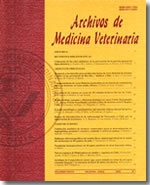Antimicrobial residues in cow carcasses
Main Article Content
Abstract
To determine the incidence of antimicrobial residues in slaughtered animals, 300 cow carcasses from a slaughter house the Xth region, Chile were analysed. Muscle and kidney samples were obtained and analysed with the three plates microbiological method which uses Bacillus subtilis BGA as sensible strain included in a nutrient agar at three pH levels (6.0; 7.2 and 8.0). Of the 300 cows analysed, 259 corresponded to normal slaughter and 41 to urgency slaughter.
he results show 13 cows positive to antimicrobial residues (4.3%) of the total. Six cases correspond to normal slaughtered cows (2.3%) and seven cases to urgency slaughtered cows (17,1%). The most frequent causes for urgency slaughter among the positive cows were, mastitis (4 from 10), lameness (2 from 7) and strange body (1 from 7).
According to the condemnation criteria used in the German legislation, 2% of the 300 cows were affected by complete carcasses condemnation. Considering the normal and urgency slaughtered cows as different populations, condemnation affected 1.5% and 4.9% of the complete cow carcasses respectively.

